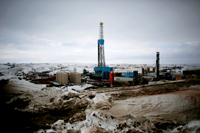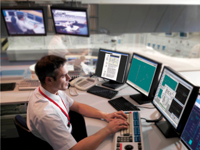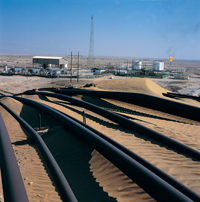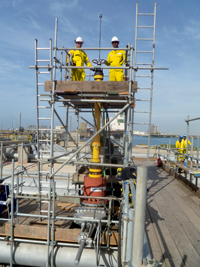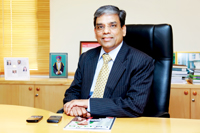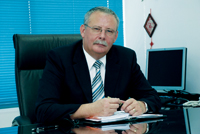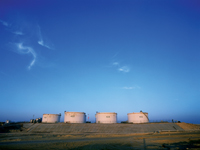
 PDO ... boosting Oman’s hydrocarbon sector
PDO ... boosting Oman’s hydrocarbon sector
OMAN’S flagship energy investment firm Oman Oil Company and its subsidiaries have pledged to sponsor projects worth in excess of $15 billion in Duqm.
The magnitude of the investments underscore the wholly government owned company’s commitment to the development of Duqm as an engine of economic growth and a major job generator, says Oman Oil CEO Ahmed Al Wahaibi.
Al Wahaibi says: “While we are proud to say that Oman Oil has projects extending from Musandam to Salalah, our next major focus will be Duqm. We are putting a lot of effort into Duqm, and will be one of the anchor investors in this region.”
Oman Oil’s commitment to Duqm, the CEO says, is reflected in its investments – either through joint venture partnerships or subsidiaries – in, among other things, a major oil refinery, crude oil and gas pipelines, and a world-scale tank farm.
Duqm Refinery & Petrochemical, a 50:50 joint venture of Oman Oil and IPIC (an energy investment firm wholly owned by the Government of Abu Dhabi), is establishing an integrated refinery complex with a capacity of around 230,000 barrels per day (bpd).
The refinery and petrochemical complex, Al Wahaibi says, will play a key role in Duqm’s industrial transformation. The plant, which will also be designed for downstream petrochemicals, will come up on a 900-hectare site at Duqm Special Economic Zone (SEZ). The facility will process imported crudes, while products will be exported to the international market. Phase 1 of the project is targeted for commissioning by 2018.
Equally significant is Oman Oil Company’s investment in a massive oil storage terminal at Ras Markaz, about 70 km from Duqm Port. “This area can easily cater for up to 200 million barrels of storage capacity. Oil traders too will take advantage of this project, whose use is not limited to storage alone,” the CEO says.
 |
Rumhy ... winning over challenges |
The project is being developed by Oman Tank Terminal Company (OTTC), a wholly owned subsidiary of Oman Oil Company. With natural depths of 32 metres, Ras Markaz will be able to accommodate Very Large Crude Carriers (VLCC). The facility will also serve as a second export hub (after Mina al Fahal in Muscat) for Oman crude oil which is proposed to be pumped via a 440km pipeline, currently under development, from Nihayda in central Oman to Ras Markaz.
Oman Oil Company is also a 90 per cent shareholder in Duqm Petroleum Terminal Company (DPTC), which is establishing a Liquid Terminal at Duqm Port. The Port of Duqm Company (PDC) is a 10 per cent shareholder in the joint venture.
The liquid jetty will act as an important link allowing refined products to be transported in and out of Duqm, saysAl Wahaibi in his presentation. Phase 1 of the liquid terminal, which is due to be operational by Q2 2017, will be sponsored by the Special Economic Zone Authority of Duqm (SEZAD). This covers the construction of jetty infrastructure, marine works (dredging and reclamation) for the new port basin, superstructures, loading/unloading arms, petroleum coke storage facilities, and associated buildings and workshops.
Phase 2 will focus on the construction of terminal storage facilities. DPTC will work together with SEZAD to carry out Engineering and Construction Management, the CEO says, adding that DPTC will operate the liquid jetty and the storage terminal.
Additionally, Oman Oil subsidiary Oman Gas Company is constructing a 230 km 36-inch gas pipeline from Saih Nihayda to Duqm SEZ, as well as a gas supply station capacity of million standard cubic metres per day (mmscumd). It is expected to be commissioned by Q1 2016.
Furthermore, Oman Oil Company is investing in the construction of two crude oil pipelines in the area. The first is a 440 km line from Nihayda booster station to Ras Markaz with a handling capacity of up to 700,000 bpd. The second is a 70 km pipeline from Ras Markaz to Duqm Refinery with a handling capacity of up to 300 bpd.
Rounding off the energy investment firm’s commitment to Duqm is its support for the development of common-user utilities in the SEZ. Takamul Investment Company, which is 95 per cent owned by Oman Oil Company, has signed an agreement with SEZAD to provide centralised utilities. The project will establish a company to provide a broad range of utilities to industrial and petrochemical zone. It will provide services such as process and cooling water, wastewater, steam, power and industrial gases.
 |
OLNG ... developing fast |
With its difficult terrain and geology, and abundance of heavy oil trapped in smaller, isolated reservoirs, Oman continues to draw companies looking to develop enhanced oil recovery (EOR) technologies. In fact, the country has achieved remarkable success with its EOR programme to become one of, if not the only hydrocarbon landscapes where all three major enhanced production techniques are in execution.
The emergence of Oman as an oil producing country was brought about under the stewardship of Mohammed bin Hamad Al Rumhy, Oman’s Minister of Oil and Gas. Over the last fifteen years, Al Rumhy has reversed field decline, bringing about a 17 per cent production increase in Oman’s production by 2007, ten years after he assumed his current position.
“Oman has a difficult geology and a difficult terrain. It is intellectually very stimulating and exciting. Financially, it is expensive and technically very difficult too,” says Al Rumhy.
The country has also a remarkable gas industry that has led it to becoming one of the top ten biggest exporters of LNG in the world.
“The gas industry is very complicated, and as times have changed so too has the outlook for gas. When we discovered gas over and above material volumes in the early 1990s, the main question on everybody’s lips was: How can we monetise that resource for the good of the country?” he says.
The answer to that question was the formation of a new company, Oman LNG. “At that stage, the thinking was to go for LNG and I think that was the right decision at that juncture. We have been very successful, and it was partly down to luck that we discovered gas when we did in the early 90s,” says the minister.
“We began exporting into the LNG world at the end of the century, and ever since the LNG market has been very healthy and probably exceeded our expectations at that time,” he adds.
Al Rumhy also observes that the swift decision-making process enabled construction to begin in the late 90s, which was good timing project-wise, predating the regional mega-project scramble of the 2000s. “We managed to construct the two LNG trains of OLNG and all that goes with it, including the pipelines and infrastructure at a good time,” he says.
“I really believe the whole LNG business in Oman came at the right time in our history and since then we’ve never looked back.”
The diversification of industries in Oman whether on the LNG side, the petrochemical side and steel clusters shows the importance attached to gas.
Gas-associated industries have contributed to Omani employment, and current estimates suggest LNG and the domestic gas-based industries, including the Oman Refineries & Petroleum company, which OLNG supports, contribute over 15 per cent of the sultanate’s overall revenue.
Of course the economic imperative for the project needed to exist as well, and this was accomplished by entering into long-term agreements with Korea and Japan.
Korea Gas Corporation (Kogas) dominates the volumes committed; taking an annual quota of 4.1 million tonnes of LNG each year in a deal running from April 2000 to December 2024. Osaka Gas of Japan and Itochu Corporation are signed up for 700,000 tonnes apiece until 2024 and 2025 respectively.
“We formed some very good sales and purchase agreements with our friends in Korea and Japan, and since then we have established a fantastic relationship with our partners in the upstream, midstream LNG- the likes of Shell, Total and Partex, as well as a great partnership with the buyers,” he says.
News about Oman’s oil and gas activities is always exciting. Petroleum Development Oman, the foremost hydrocarbon exploration and production company in Oman, which is responsible for approximately 90 per cent of the country’s oil production and virtually all of its natural gas supply, has recently announced a significant gas find in the northern part of its concession area.
The Mabrouk Deep, some 40 km west of Saih Rawl, Oman’s main gas field, has estimated in-place volumes amounting to 2.9 trillion cubic feet of gas and 115 million barrels of condensate. Exploratory drilling took place last year at depths of up to 5,000 metres and a large field of some 60 sq km was located.
In addition, there were five new oil discoveries in 2012, amounting to approximately 300 million barrels of stock tank oil initially in place, from Shuaiba and Gharif reservoirs.
“The scale of the find at Mabrouk is tremendous news for Oman as it will enable a further significant boost to economic growth and social development,” says PDO managing director Raoul Restucci.
“The discovery underlines the truly excellent work that our exploration directorate is conducting to identify and appraise new hydrocarbon reservoirs which will sustain the Sultanate for many years to come,” he adds.
The announcement came as PDO declared that it had enjoyed a record year with the highest every hydrocarbon production in its history, 1.24 million barrels of oil equivalent (boe) per day.
Daily oil production has stood at 566,305 bpd and above PDO’s long term plateau target of 550,000 bpd. Daily production of non-associated and associated gas stood at 582,500 boepd with condensates at 92,500 bpd. The combined yield meant it was the fifth successive year that the company has increased its aggregate production figures.
“PDO accounts for around 70 per cent of the country’s crude oil production and nearly all of its natural gas supply, so there is a huge onus on us to find and develop new fields of a challenging or “unconventional” nature to replace those that are declining,” says Restucci.
“Despite our record year, we remain as committed as ever to our primary goal of exploring and developing hydrocarbons in a sustainable, efficient manner to the benefit of all our stakeholders by using new technology and pioneering techniques such as enhanced oil recovery.”
Restucci also says that the focus in 2013 is to see an intensification of effort in key areas such as exploration, EOR, business efficiency ICV and social investment. He highlighted the fact that the exploration directorate is planning to drill around 100 wells over the next five years and spend more than $800 million in its search for new reservoirs.
Between now and 2022, there will also be 16 significant new projects comprising over $11 billion of investment and targeted at developing over a billion barrels of oil. Last year, the company made a $26 billion investment in hydrocarbon exploration and production activities over five years. According to Restucci, the projected investments cover oil and gas operations and employment opportunities in hydrocarbon streams.
Restucci states that PDO has set a target of creating 4,000 Omani jobs per year over the five-year business plan. With the doubling of global energy demand projected by 2050, the Middle East will continue to be a significant supplier of gas, as demand for gas increases, there is a much greater responsibility and economic imperative for IOCs and NOCs to find and extract it.
“We have to continuously find and invest in the best talent and technology to discover and recover gas and review the entire supply chain to make sure the exploration and development process is more economical,” says Restucci.
Deeper and together fields mean drilling further down and for longer, creating its own known-on effects in terms of environmental safety and social consequences.
“For PDO this means not only complying with increasingly more stringent HSE rules and regulations but also achieving and retaining a social license from the communities where we operate. We need and want their consent to operate and this means investing in vital infrastructure, education, vocational training and job creation in those areas,” he explains.
The company also recently commissioned the country’s first solar Enhanced Oil Recovery (EOR) project alongside GlassPoint Solar. Thermal EOR is a technique used to facilitate the recovery of heavy oil with the injection of high pressure steam which can increase the temperature of oil reserves and change reservoir consistency.
By harnessing the sun’s energy with GlassPoint’s enclosed trough technology, the solar EOR project produces a daily average of 50 tonnes of emissions-free steam that can be fed directly into existing thermal EOR operations at PDO’s Amal West field in Southern Oman.
The 7 MW system is in regular operation and recently passed its first performance acceptance test.



















































































